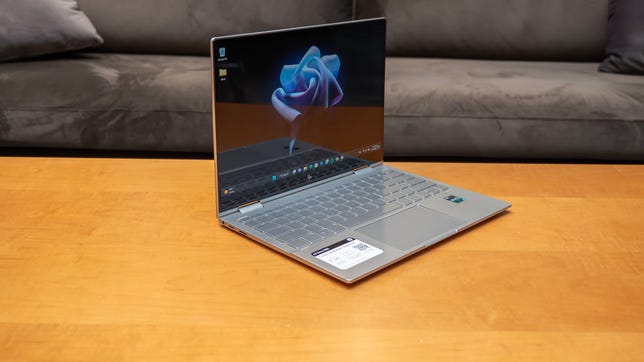Technologies
HP Envy x360 13 Review: Midrange 2-in-1 That’s Short on Battery
This compact convertible is customizable, and we suggest you take advantage of the reasonable upgrade prices.
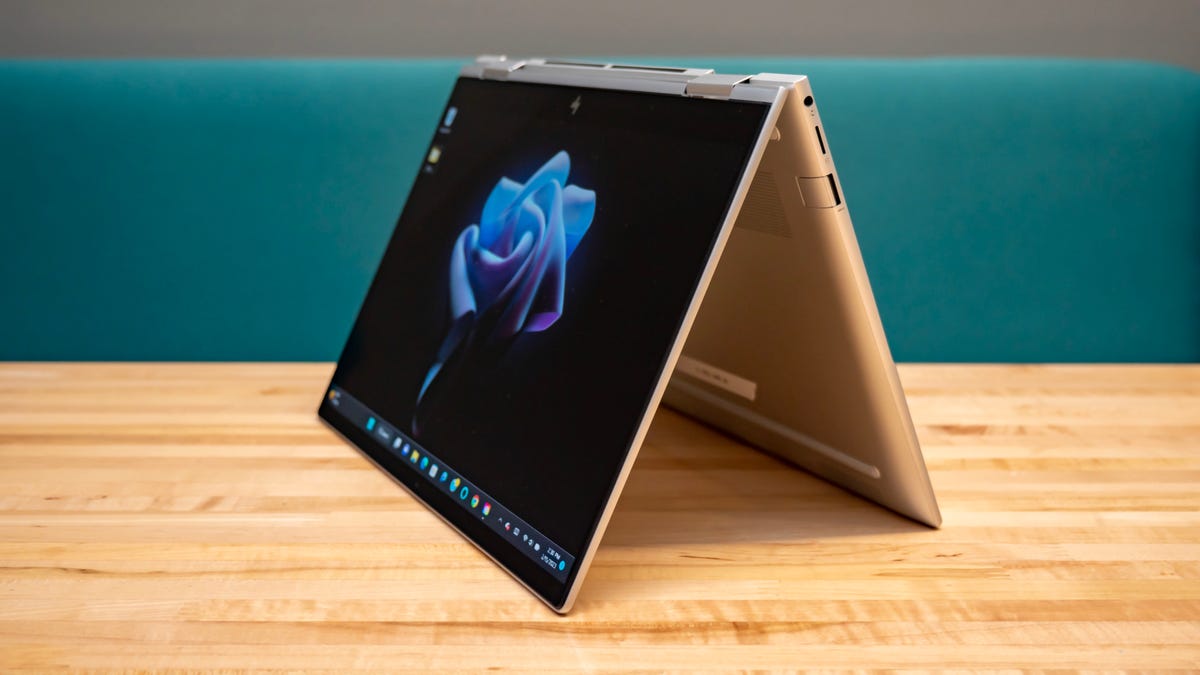
The HP Envy x360 13 is a compact, midrange two-in-one based on a 13.3-inch touch display with a tall 16:10 aspect ratio that makes the screen feel roomier than a 13.3-inch widescreen display. Still, it’s less screen than you get with the 14-inch, 16:10 Lenovo Yoga 7i, which remains our favorite two-in-one for most buyers. At $1,050, the HP Envy x360 model we tested costs a bit less than the Yoga 7i we looked at, but we think the Yoga 7i is worth the extra funds.
For starters, the Envy x360 13 isn’t any lighter than the 14-inch Yoga 7i, so there’s no weight penalty to pay for the added screen real estate. More to the point, the Envy x360 13 we tested supplies only 8GB of RAM. Any laptop or convertible with a price north of $1,000 should serve up 16GB of memory, as the Yoga 7i does. The meager memory allotment holds back the Envy x360 13’s performance. Its battery life also failed to impress, and we aren’t fans of the silver-on-silver, low-contrast keyboard. Unless you find the Envy x360 13 on sale at a substantial discount, we would steer two-in-one shoppers to the Yoga 7i.
Like
- Rigid, metal chassis
- HP offers affordable upgrade options
- 1440p webcam
Don’t Like
- Only 8GB of RAM hampers performance
- Poor contrast between keys and key symbols
- Disappointing battery life
Our test model (13-bf0013dx) is available at Best Buy for $1,050. You can also find it for the same price at HP.com. Best Buy and HP are constantly rotating sales, and while our review configuration is not marked down at Best Buy right now, it’s $200 off at HP and selling for only $850. The line starts at $900 at HP for a system with the Core i5-1230U processor, and this baseline model is also $200 off and selling for $700. Upgrading to the Core i7-1250U CPU of our test system is a $150 upgrade on the customizable model on HP’s site. And for a $220 upgrade, you can get the Core i7-1250U and 16GB of RAM — a much better option than the $150 CPU-only upgrade we received.
HP also offers two display upgrades, both of which are aggressively priced. We received the baseline display, an IPS LCD touch panel with a 1,920-by-1,080 resolution. For $30 more, you can upgrade the resolution to 2,560-by-1,600. That’s a reasonable sum for the added pixels, but the baseline display looked plenty crisp across its 13.3 inches on our test system. However, the $60 display upgrade gets you an OLED panel with a 2,880-by-1,800 resolution. We’d happily spend that amount for the incredible color and contrast that an OLED panel delivers. In the UK, the Envy x360 13 starts at £730 for an AMD Ryzen 5-based config and £750 for a Core i5-based model. In Australia, it’s AU$999 for a Ryzen 5 model and AU$1,399 for a Core i5 model.
With the upgrade to the Core i7-1250U CPU but with the baseline 8GB of RAM, our Envy x360 13 test system trailed competing two-in-ones from Dell and Lenovo that feature similar 12th-gen Intel U-series chips but with 16GB of RAM. As configured, the Envy x360 13 will suffice for basic office tasks but is a poor choice for more intensive creative work that requires more RAM and better graphics. Perhaps the most surprising test result was its lackluster runtime; it lasted only eight hours on our battery drain test. That might be enough to squeeze out an entire workday on a single charge, but other two-in-ones can run for hours longer on a single charge.
HP Envy x360 13-bf0013dx
| Price as reviewed | $1,050 |
|---|---|
| Display size/resolution | 13.3-inch 1,920 x 1,200 touch display |
| CPU | 1.1GHz Intel Core i7-1250U |
| Memory | 8GB LPDDR4x-4266 MHz RAM (onboard) |
| Graphics | 128MB Intel Iris Xe Graphics |
| Storage | 512GB PCIe NVMe M.2 SSD |
| Networking | Wi-Fi 6E (2×2)(19c) and Bluetooth 5.3combo (Supporting Gigabit data rate) |
| Operating system | Windows 11 Home 22H2 |
Slim and silver
The Envy x360 13 boasts a trim, all-metal chassis that’s only 0.63-inch thick and weighs only 3 pounds. It’s eminently portable, but the 3-pound weight begins to feel less impressive when considering the slightly larger, 14-inch Yoga 7i also weighs 3 pounds.
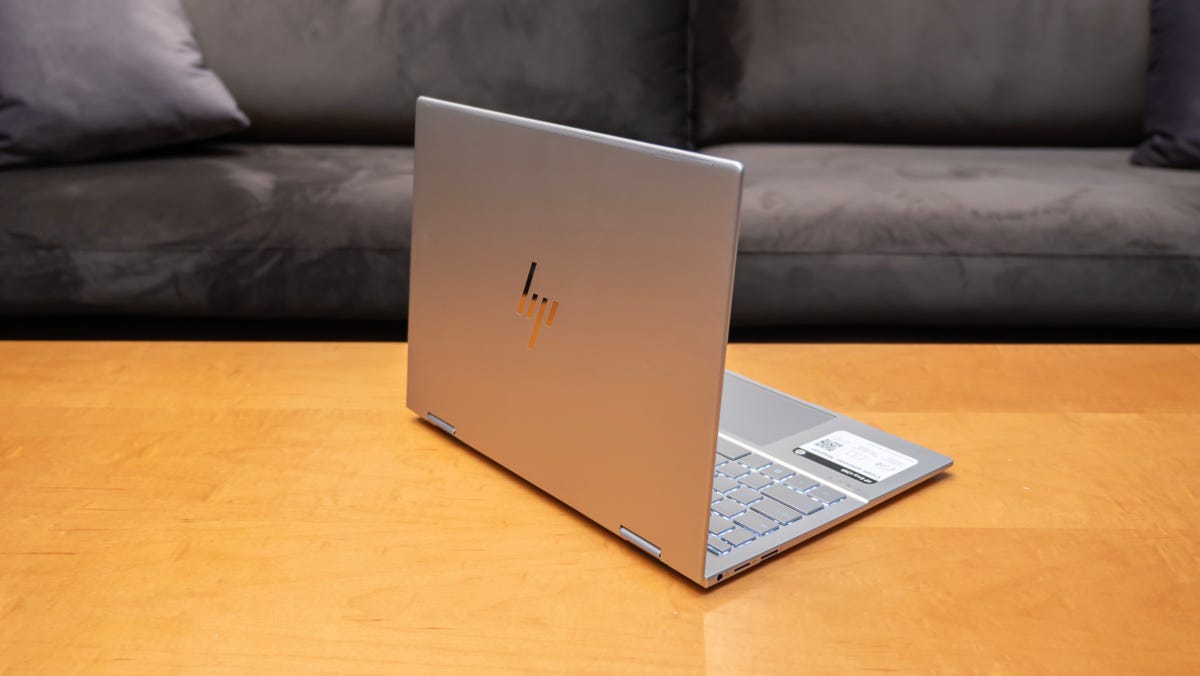

I don’t take issue with the Envy x360 13’s size or weight, but I do have a problem with the silver keyboard. The keys match the rest of the system — silver lid, silver keyboard deck and silver bottom panel. That’s a lot of silver. I don’t mind the monochrome design, but the silver keys are hard to read because there’s little contrast between the silver keys and dark gray key symbols. The Envy x360 13 would look equally sleek with a traditional black keyboard and be much easier to use. The keys themselves are flat, with shallow travel and snappy feedback. And they offer two-level backlighting, which I had to frequently employ to see which key was which.
For such a small laptop, the touchpad looks and feels roomy. It accurately recorded my mousing gestures, and its click response was just about perfect. It’s quiet when clicked with a firm-but-not-too-firm feel.
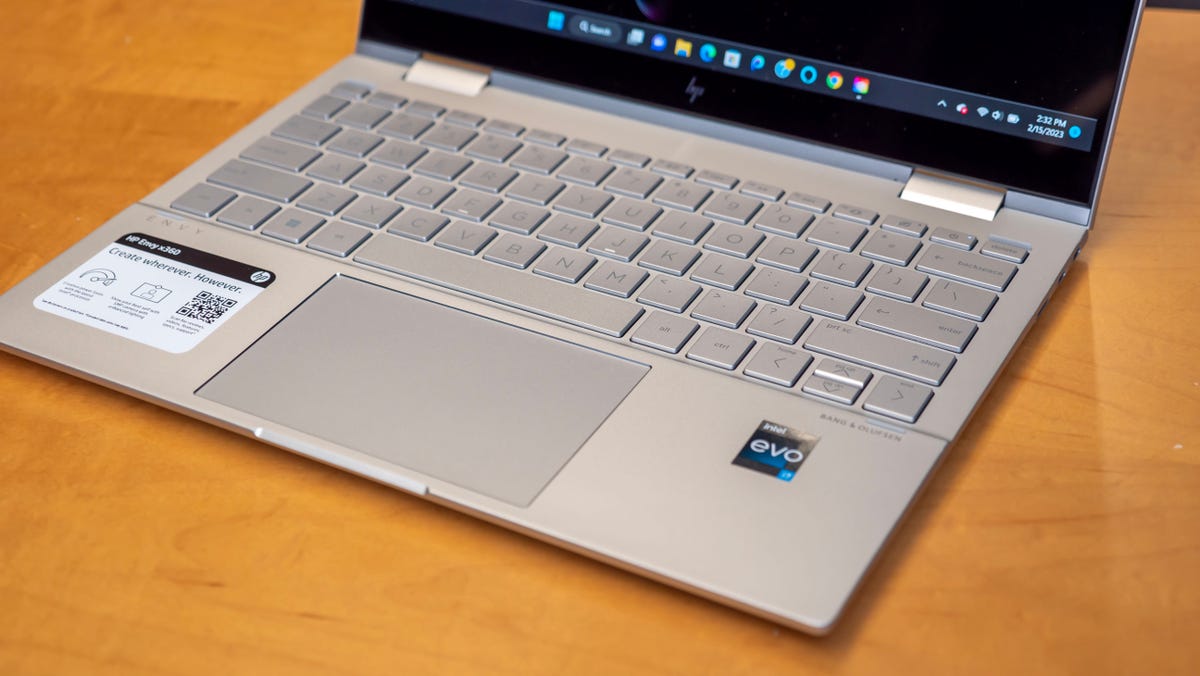

Before 16:10 laptop displays started replacing widescreen 16:9 panels, I would have said a 13.3-inch laptop is too small for your everyday laptop, even if you needed to carry it to work or class each day. You’d be better off with a 14-inch model for the added screen space at the expense of toting a few more ounces in your laptop bag. The 13.3-inch, 16:10 has me rethinking this advice. It was large enough to work comfortably, including multitasking and juggling multiple windows. The 1,920-by-1,200 resolution is plenty crisp on the 13.3-inch panel and offers plenty of brightness. It’s rated for 400 nits of brightness, and I measured it to be even a bit brighter than that at 460 nits.
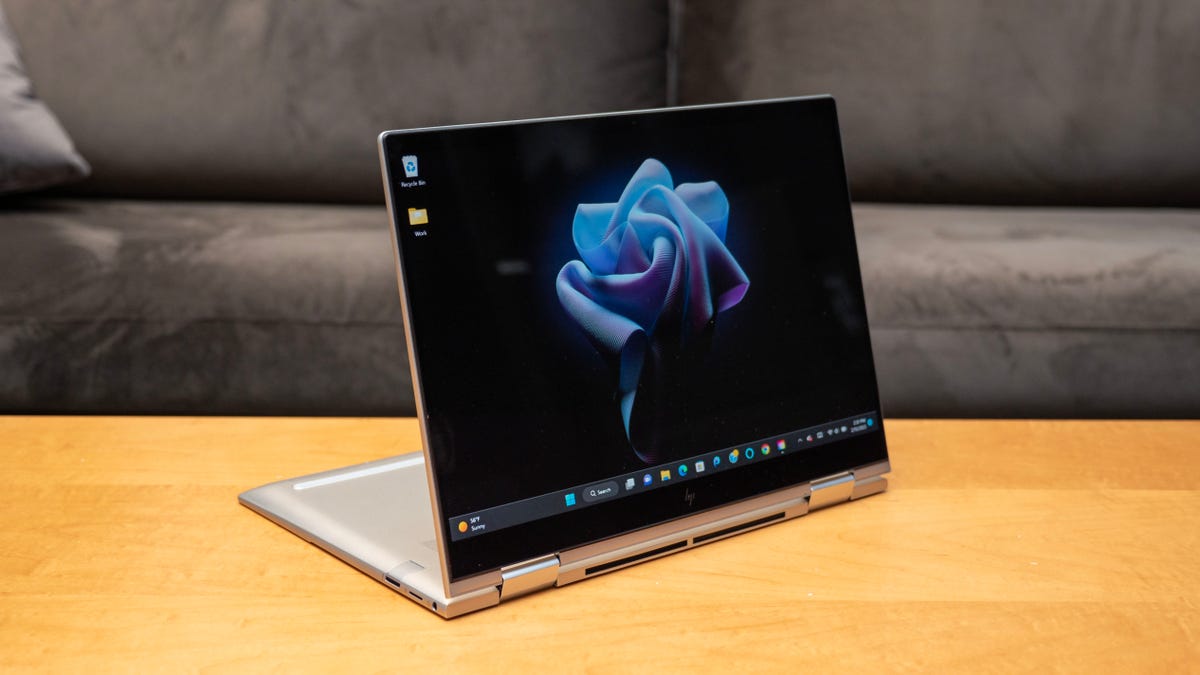

The 13.3-inch, 16:10 panel also feels natural with the display rotated 360 degrees into tablet mode. Larger 15.6-inch and narrower 16:9 panels can feel a bit unwieldy when used as a tablet. I could hold the Envy x360 in one hand without issue or awkwardness and swipe and tap on the screen with the other. A stylus, however, was not included with our test system. On Best Buy, it states that a stylus is not included, but if you buy from HP, an HP Rechargeable MPP2.0 Tilt Pen is included in the price.
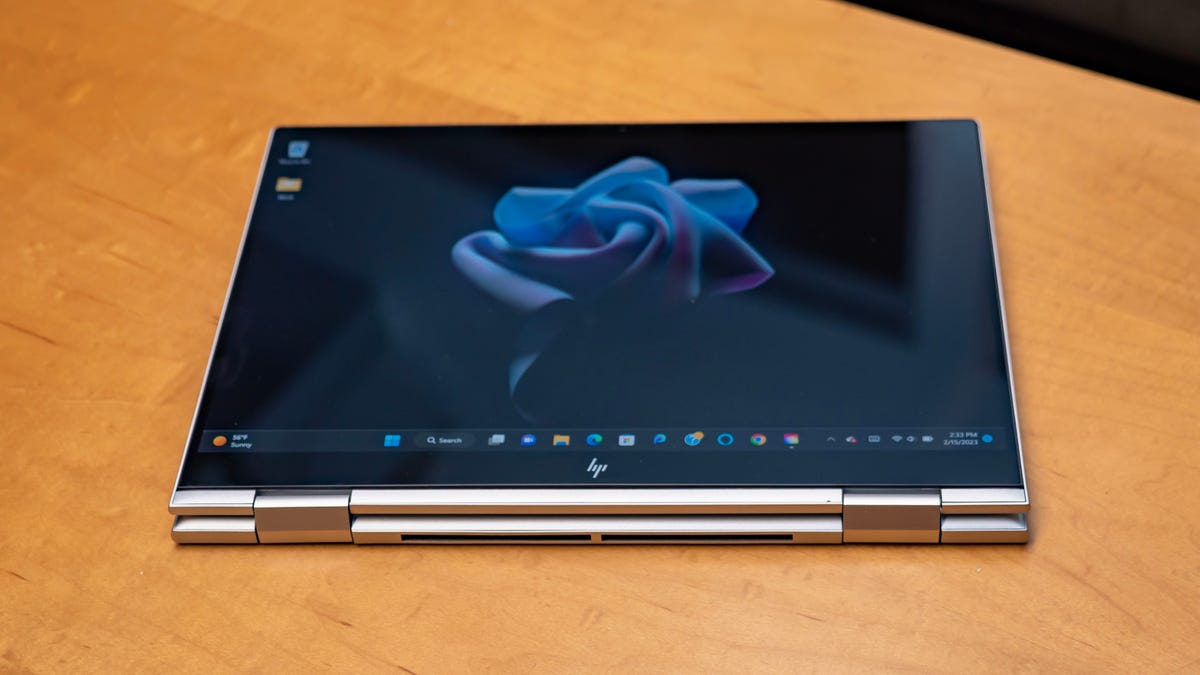

The Envy x360 13 boasts a 1440p webcam that produces an incredibly crisp picture that makes the previous-gen 720p cameras look like grainy, poorly balanced garbage. It’s also an IR cam that you can use to sign in simply by placing your face in front of the display. Without a fingerprint reader, the camera is the system’s only biometric security feature.
The laptop offers a pair of USB Type-A ports and a pair of USB-C ports with Thunderbolt 4 support. You also get a microSD card slot. Missing are HDMI and Ethernet ports. HP includes a USB-C-to-Ethernet adapter, but it would have been nice if that adapter also had an HDMI connection.


With a trim, aluminum chassis and a bright, fairly roomy 13.3-inch display, the HP Envy x360 13 has the makings of a versatile yet portable two-in-one convertible. In the end, the Lenovo Yoga 7i outclasses it by offering a larger display at the same 3-pound weight, better performance and much longer battery life. With HP’s customization options at affordable prices, you don’t need to spend all that much more to configure a better Envy x360 13 machine that includes 16GB of RAM and an OLED display. We still would worry about the battery life since you cannot upgrade to a bigger battery.
How we test computers
The review process for laptops, desktops, tablets and other computer-like devices consists of two parts: performance testing under controlled conditions in the CNET Labs and extensive hands-on use by our expert reviewers. This includes evaluating a device’s aesthetics, ergonomics and features. A final review verdict is a combination of both objective and subjective judgments.
The list of benchmarking software we use changes over time as the devices we test evolve. The most important core tests we’re currently running on every compatible computer include: Primate Labs Geekbench 5, Cinebench R23, PCMark 10 and 3DMark Fire Strike Ultra.
A more detailed description of each benchmark and how we use it can be found in our How We Test Computers page.
Geekbench 5 (multicore)
Note:
Longer bars indicate better performance
Cinebench R23 (multicore)
Note:
Longer bars indicate better performance
3DMark Wild Life Extreme
Note:
Longer bars indicate better performance
PCMark 10 Pro
Note:
Longer bars indicate better performance
Online streaming battery drain test
Note:
Longer bars indicate better performance
System configurations
| HP Envy x360 13-bf0013dx | Microsoft Windows 11 Home; 1.1GHz Intel Core 17-1250U; 8GB DDR4 4,266MHz RAM; 128MB Intel Iris Xe Graphics; 512GB SSD |
|---|---|
| Lenovo IdeaPad Flex 5i | Microsoft Windows 11 Home; 1.3GHz Intel Core i5-1235U; 16GB DDR4 4,266MHz RAM; 128MB Intel Iris Xe Graphics; 512GB SSD |
| Dell Inspiron 14 7420 2-in-1 | Microsoft Windows 11 Home; 1.7GHz Intel Core i7-1255U; 16GB DDR4 3,200MHz RAM; 128MB Intel Iris Xe Graphics; 512GB SSD |
| Lenovo Yoga 7i (Gen 7) | Microsoft Windows 11 Home; 1.7GHz Intel Core i7-1255U; 16GB DDR5 6,400MHz RAM; 128MB Intel Iris Xe Graphics; 512GB SSD |
Technologies
The Most Exciting Video Game Rumors and Leaks Ahead of 2026
Technologies
Today’s NYT Mini Crossword Answers for Wednesday, Dec. 17
Here are the answers for The New York Times Mini Crossword for Dec. 17.

Looking for the most recent Mini Crossword answer? Click here for today’s Mini Crossword hints, as well as our daily answers and hints for The New York Times Wordle, Strands, Connections and Connections: Sports Edition puzzles.
Need some help with today’s Mini Crossword? Read on. And if you could use some hints and guidance for daily solving, check out our Mini Crossword tips.
If you’re looking for today’s Wordle, Connections, Connections: Sports Edition and Strands answers, you can visit CNET’s NYT puzzle hints page.
Read more: Tips and Tricks for Solving The New York Times Mini Crossword
Let’s get to those Mini Crossword clues and answers.
Mini across clues and answers
1A clue: Nod (off)
Answer: DOZE
5A clue: Naval submarine in W.W. II
Answer: UBOAT
7A clue: Tricky thing to do on a busy highway
Answer: MERGE
8A clue: Heat-resistant glassware for cooking
Answer: PYREX
9A clue: Put into groups
Answer: SORT
Mini down clues and answers
1D clue: Break up with
Answer: DUMP
2D clue: Falls in line, so to speak
Answer: OBEYS
3D clue: Legendary vigilante who cuts a «Z» with his sword
Answer: ZORRO
4D clue: Rarin’ to go
Answer: EAGER
6D clue: Common reminder for an upcoming appointment
Answer: TEXT
Don’t miss any of our unbiased tech content and lab-based reviews. Add CNET as a preferred Google source.
Technologies
You Can Watch an Exclusive Avatar: Fire and Ash Scene on TikTok Right Now
Disney and TikTok partner on an immersive content hub for James Cameron’s latest movie about the alien Na’vi.
If you’re not quite ready to head to the theater to watch Avatar: Fire and Ash, an exclusive scene preview might sell you on the visual spectacle. As part of a new collaboration with the social media giant, Disney is posting snippets of its new movie to its TikTok account.
This scene isn’t part of any trailer and won’t be posted to other social media accounts, making TikTok the only place you can view it — unless you buy a movie ticket. A first look at the new movie’s scenes isn’t the only Avatar-related bonus on the social media platform right now, either. TikTok has partnered with the house of mouse to bring an entire «immersive content hub» to the app.
A special section of TikTok includes quizzes and educational videos that explore the alien world of Pandora shown off in the movies. On TikTok, you can take a personality quiz to find out what Na’vi clan you most closely align with and unlock a special profile picture border to use on your account.
Science and fiction blend together with a series of videos from real doctors who explain the basis for some of Avatar’s world-building. If you want to learn about exoplanets or how realistic the anatomy of the movie’s alien animals is, these videos will feed your brain while still providing entertainment value.
Perhaps the most enticing part of Disney’s latest social media collaboration is the opportunity for fans to win prizes and trips. TikTok creators who make edits with the #TikTokAvatarContest hashtag are entered into a competition to win Avatar merchandise. The biggest winners will be able to take a trip to visual effects studio Wētā Workshop in New Zealand or visit Avatar director James Cameron’s Lightstorm Entertainment Studio in Los Angeles.
Avatar: Fire and Ash is the third installment in director Cameron’s cinematic passion project. While the first Avatar movie was released in 2009, Cameron didn’t release another entry in the franchise until 2022. In total, there is a five-movie arc planned for the indigo alien Na’vi on the moon of Pandora.
The Avatar movies are known for pushing the boundaries of CGI visual effects in cinema. They are also historically big winners at the box office: the original Avatar is the highest-grossing film of all time, earning $2.9 billion across its theatrical releases. Its sequel, Avatar: The Way of Water, is the third-highest-grossing film of all time, trailing Avengers: Endgame. You can stream those movies on Disney Plus.
It remains to be seen whether Avatar: Fire and Ash will financially live up to its predecessors. The film currently has mixed reviews from critics on Rotten Tomatoes.
-

 Technologies3 года ago
Technologies3 года agoTech Companies Need to Be Held Accountable for Security, Experts Say
-

 Technologies3 года ago
Technologies3 года agoBest Handheld Game Console in 2023
-

 Technologies3 года ago
Technologies3 года agoTighten Up Your VR Game With the Best Head Straps for Quest 2
-

 Technologies4 года ago
Technologies4 года agoBlack Friday 2021: The best deals on TVs, headphones, kitchenware, and more
-

 Technologies4 года ago
Technologies4 года agoVerum, Wickr and Threema: next generation secured messengers
-

 Technologies4 года ago
Technologies4 года agoGoogle to require vaccinations as Silicon Valley rethinks return-to-office policies
-

 Technologies4 года ago
Technologies4 года agoOlivia Harlan Dekker for Verum Messenger
-

 Technologies4 года ago
Technologies4 года agoiPhone 13 event: How to watch Apple’s big announcement tomorrow

